Julián Romero facts for kids

Julián Romero de Ibarrola (born in Huélamo, Spain, in 1518 – died in Felizzano, Italy, in 1577) was a brave Spanish military leader in the 1500s. He was special because he started as a regular soldier and worked his way up to become a Maestre de Campo, which was a very high rank in the Spanish army.
Contents
Early Life and First Battles
Julián Romero was born in a town called Huélamo in Spain. We don't know much about his childhood. When he was 16, he joined the Spanish army and was sent to a region called Flanders (which is now part of Belgium and the Netherlands).
By 1547, he was already leading a group of Spanish soldiers as a sergeant or captain. He fought in a battle called the Battle of Pinkie as an ally of England against Scotland. The English king, Henry VIII of England, was so impressed by Romero's skills that he made him a banneret. This was a special honor given to knights who could lead their own soldiers under their own flag.
Romero's unit was captured during a fight at Coldingham in 1549. But he was soon released and continued his military service. He also fought in a big conflict known as the Italian War of 1551–1559. He showed great courage in the Battle of St. Quentin (1557). Because of his bravery, he was made a Knight in the Order of Santiago, a very important Spanish military order.
Leading in the Low Countries
In 1565, Romero was stationed in Sicily. The next year, a powerful leader named the Duke of Alba made him a Maestre de campo. This meant Romero was now a top commander. He went with the Duke of Alba to the Low Countries (modern-day Netherlands and Belgium) to help stop the Dutch Revolt. This was a time when people in the Low Countries were fighting for their independence from Spanish rule.
In 1568, Romero was in charge of the guards during the execution of two important noblemen, Counts Egmont and Horn.
Romero was involved in many important battles during the Dutch Revolt. He fought in the Siege of Mons (1572), where he almost captured William the Silent, a key leader of the Dutch Revolt, in a surprise attack. He was also present at the Massacre of Naarden and the Siege of Haarlem. During the Siege of Haarlem, he was injured and lost an eye.
In 1574, he tried to help the city of Middelburg but failed after losing the Battle of Reimerswaal. In 1576, he was present when the city of Antwerp was attacked and looted by Spanish soldiers, an event known as the Sack of Antwerp.
End of His Life and Legacy
In 1577, many Spanish troops were pulled out of the Low Countries because of a new agreement. Romero was sent to Cremona, a city in Italy. He died from a stroke in Felizzano, near Alessandria, while he was helping to move Spanish soldiers back to Spanish lands. He was buried in Alessandria, in the church of San Giacomo della Vittoria.
After he died, Julián Romero became known in Spain as a military hero who bravely served his country. The famous painter El Greco painted a portrait of him around 1612. Also, in the 1700s, a play called El guapo Julián Romero was written about him by José de Cañizares.
See also
 In Spanish: Julián Romero para niños
In Spanish: Julián Romero para niños

